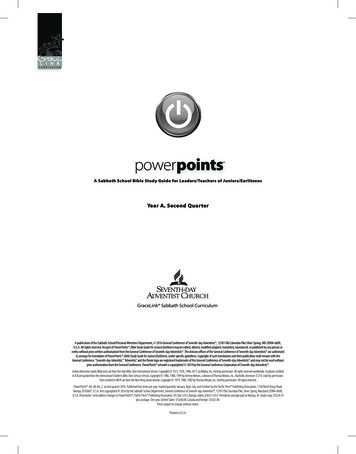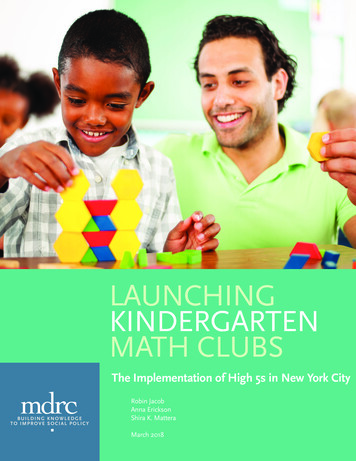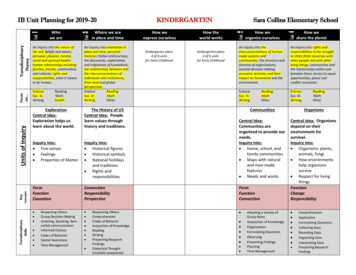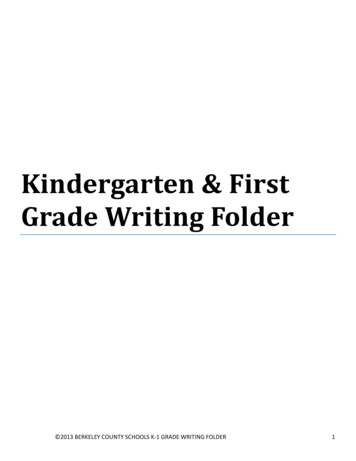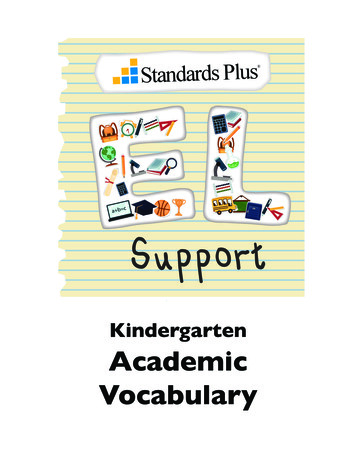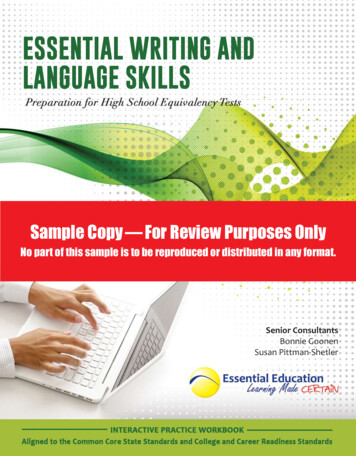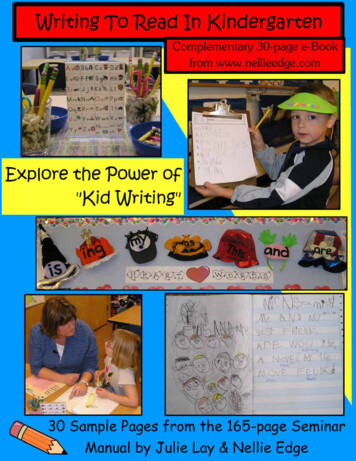
Transcription
Writing to Read in Kindergarten: Explore the Power of “Kid Writing”A Complementary Seminar Sampler (e-Book) from Julie Lay and Nellie EdgeTable of Contents1. Rituals That Build Our Learning Community2. A Circle of Respect3. “Midge” The Hedgehog4. Management and Planning Essentials For Literacy Environments5. Keep Books Accessible6. Name Word Walls Help Us Write About Our Friends7. Teaching The Concept of “Word”8. Fun With “THE”9. “By Heart” Word Walls Features Only High-Frequency Words10. Write The Room11. Block Building and Kid Writing Go Together12. Kinders Make “Skinny Books” Using Word Stamps13. Our Study of Leaves14. Spring Smiles on Us With Weather Similes15. Bird Projects: Combine Art, Writing and Joyful Learning16. Alias Letter “Y”17. Where Do People Read and Why Do People Read?18. Read Together Notebooks Support Emergent Readers19. We Connect Oral Language to Print: I Like Stars20. Book Boxes Encourage Independent Reading21. Teaching Comprehension Through Schema22. Build Comprehension and Vocabulary Through Word Work23. Teaching Comprehension: Use Mind Pictures and Questioning Strategies24. The Center of Our Classroom is a Library25. Student-Led Conferences26. About Julie Lay27. About Nellie Edge28. Julie Lay’s Writing Resources: Where To Get Them29. Julie Lay’s Writing Resources Continued30. Writing to Read in Kindergarten: Our Valued Resource Books An invitation to study “Kid Writing” with Julie Lay Promoting Excellence in Kindergarten Literacy www.nellieedge.com 2008
Rituals That Build Our Learning Community “The Lighting Circle”“The Lighting Circle” is a much-anticipated ritual conducted twice a week. OnMonday, children enter the room with the main lights turned off. As they quickly putbackpacks and coats away, they are already thinking about what they will share about theirweekend. After everyone is seated quietly in a circle, the candle is lit. I focus them furtherby saying, “Think about what you did, places you went or people you saw thisweekend.when you have your idea in your head, put your thumb up to let us know you‟reready.” „Red‟, our class-sharing hedgehog, is passed from child to child as they share ahighlight or thought from their weekend.After sharing, we announce our learning circle is open for the upcoming week and a childblows out the candle.This process is repeated on Friday just before the children are dismissed. However,this time the children share a highlight or something they learned at school during theweek. After everyone has had a turn, we announce our learning circle is now closed forthe week and a child blows out the candle.Credit for this idea is given to Andie Cunningham and Ruth Shagoury in the their book, Starting With Comprehension:Reading Strategies for the Youngest Learners, Stenhouse, 2005.1
A Circle of Respect.Our Promises To One AnotherHaving the children write their own promises (rules) for each other helps establisha community of learners who work together better than a dictated list of rules that theteacher makes arbitrarily. In a child’s mind, a rule can be broken, but a promise mustbe kept. The kids generate their own list (usually longer than I would do) and I act astheir scribe to put their words on paper. And yes, it is okay to keep adding or changingthem as the year progresses! After agreeing to the promises, the kids must come up with areasonable consequence for broken promises. This is also written on the circle of respectpromise board.After coming up with a list, children then sign their names around the edge of thecircle pledging their allegiance to their promises. They are also issued a clothespin withtheir name on it which is then clipped to the outside edge of the circle. If someone breaksa promise, they are asked to move their clip from our ‘Circle of Respect’ to anotherlocation (simply a yellow paper hanging on the wall under the promise circle) and followthe consequence listed. Children earn back their spot in the circle by demonstrating totheir classmates that they can follow the formally broken promise. This places moreresponsibility on the children, rather than an authoritarian figure.Credit for this idea given to Andie Cunningham and Ruth Shagoury in their book, Starting With Comprehension: ReadingStrategies for the Youngest Learners, Stenhouse, 2005.2
“Midge” The HedgehogOur Class PetOur class mascot is a Hedgehog. We actually do have a real hedgehog pet and her nameis “Midge.” Having a live animal to care for makes a great learning experience for kids—especially one that is rather unusual. Having a pet hedgehog also invites children to learnabout their care, babies, and different types of hedgehogs. Providing resource books frompet stores about hedgehogs gives the children an opportunity to read or want to read abouthedgehog care.Having a live pet also provides opportunity for drawing and life lessons about whathappens when a pet dies. One of our pet hedgehogs died two years ago and that gave us anopportunity to draw and write about our beloved pet. We wrote an entire book about ourpet “Miss Prickles.” Here are some examples of the children’s drawings:3
Management & PlanningEssentials For Literacy EnvironmentsCreating a literacy environment takes some careful thought, planning and bargainhunting. Exemplary learning environments weave together the right amount of color,light, sound and smells to create a home-like atmosphere.Color: Light blues and greens are thepredominate color scheme in theclassroom. Accenting with yellows,reds, and oranges creates the rightbalance for exceptional learning.Blues and greens are purposefullychosen because of their calmingeffect on behavior.Light: Outside lighting is by far the best,however many classrooms have limitedwindows. You can eliminate some of the flickeringeffect from fluorescent lights by strategically placingincandescent lamps to create a home-like feel.Remember the fire marshal’s rules about the use ofextension cords and use a maximum of 60-watt bulbswhen planning your room’s layout.Sound: Music plays an important role in theclassroom feel beyond its use for singing ordancing. Try using “relaxation” music CDsduring work time. Remember to play themsoftly enough so as not to disrupt work, yetloud enough to be heard. You can also usesmall water fountains or bubblers as anaccent for relaxation.The addition of recycled tennis balls onthe bottoms of chairs not only helps innoise reduction, but the custodians singour praises for not having to rewax the floormid-year!4
Keep Books Accessible: Invite Children to ReadRain gutters create an excellent way to display books so that the covers are visible.These are inexpensive and are easily installed under windows, chalkboards or bulletin boardsand enhance the literacy “feel” of the room.Keep in mind, as you build your class library, that students do not naturally select leveledreaders or highly structured reading collections. Phonics readers are another group of booksthat do not command the attention of students. Children love real books.Don’t forget about the Big Books in yourclassroom library. Here is a great way tostore them: a cardboard box covered withcontact paper. Add cardboard dividers.5
Name Word Walls Help Us Write About Our FriendsA useful and meaningful “first-word wall” for children will feature their names. Analphabetical chart kept in the meeting area becomes a helpful reference during grouplessons. Color-matched beginning letters can easily be seen for discussion.I take a close-up photo of each child on the first day of school and mount it on a 3"X5" index card along with their name. Children can remove the names any time duringthe day to copy. The flexibility of a small pocket chart for this word wall makes it easierto add or delete names as the year progresses.Family Name WallKinders often want to use family member’s nameslike “Grandpa Joe” or “Aunt Sue” in their writing. It ishelpful to generate a small word wall (in chart form) tohave for children to reference.Some teachers ask children to draw a picture andlabel the names of all the people and animals intheir family. They keep this reference in their writingfolder.6
Teaching The Concept Of “Word”Many children enter kindergarten not knowing what a word is, or thedifference between letters and words. Teachers can use pocket chart strategiesto help children pay focused attention to how words and sentence syntax works.Sentence strips are cut apart into individual words for ease of manipulating andhighlighting text and for ease of storage. Key words are highlighted withcolored acetate overlays. This helps even the emergent reader begin tointernalize and „visualize‟ the concept of word.Where to store long sentencestrips is often a concern forteachers. By cutting apart sentencestrips into individual words, youhave an easy storage solution.Leaving spaces between individualwords (as shown below) makes iteasier for emergent readers to graspthe “concept of word”. In thepocket chart photo below, childrencan easily “see” and manipulateindividual words.Color Overlays Highlight HighFrequency (“By Heart”) WordsThe colored words are merely cutto-size acetate paper (from reportcovers). On previous lessons,students were locating „by heart‟words and marking them with theacetate color overlays. Childrenenjoy finding all the words theyknow “by heart.” You canpurchase pre-made pocket charthighlighter strips fromwww.abcstuff.com (item numberHT010).7
Fun With “THE”The little word “the” is not an exciting, emotionally appealing word all by itself, yet it is ahigh-frequency word young readers will need automatic mastery of early on. Wise,imaginative teachers of young children understand how to use the power of movement,rhythm and rhyme to create memory hooks for word study. They recognize children are firstauditory spellers and they want all children to engage in joyful, satisfying literacy events.Consider the following explicit multisensory teaching:“You Can Say „the‟ chant a jivy chant that demonstrates the two pronunciations of “the”in a rhythmic spelling way. Start by setting up a strong, 3-beat rhythm (stomp stomp clap,stomp stomp clap) while chanting You can say the,You can say thee,But it’s always spelledT-H-E !After learning the chant, kids make their first “By-Heart” wordnecklace to take home and show off. This will be the first wordto appear on the “By-Heart” word wall in the classroom.“The End” is a meaningful and useful phrase. Our Read and Sing Big Books and LittleBooks all end with the words: “The End.” We want children to confidently anticipatechanting and reading those last two words. To emphasize these words, I teach children tocarefully articulate and recite in a 3-beat rhythm: “T-H-E E-N-D, The End!” Childrenquickly come to recognize the letters and words. Many will write “The End” independentlyon their own Little Books and writing projects all year long. The repetition builds instantword recognition. Julie Lay’s kindergartners enjoy a “T-H-E E-N-D The End—Do it again!”spelling chant by standing up and swinging their hips and arms to a “Cha-cha-cha” rhythm tocelebrate the last page of their Nellie Edge Read and Sing Big Books.Special thanks to Jennifer Foster for the “THE” chant!8
“By Heart” Word Wall Features Only High- Frequency WordsThe main word wall inthe room should onlyfocus on highfrequency words. Byfocusing on only thesehigh utility words,space is maximizedfor environmental ortheme related print inother locations in theroom whileminimizing the spaceneeded for onepermanent word wall.Resist the temptationto display children’snames on this board.Some teachers call high-frequency words “Star Words” because the words are ‘special’like stars. Others call them “Popcorn Words” because they are always ‘popping up.’ Iprefer the term “By Heart Words” because the children need to know these words ‘byheart.’FingerspellingTo help make connections between a written letter and itscorresponding sign, I have combined two different alphabets:the heart alphabet and the sign language alphabet. These aredisplayed at the children’s height so the large sign languagehand shapes are easy for them to form. Children practice byholding their hand on top of the picture.The Sign Language Alphabet Line by TS Denison is available atwww.frankshafferpublications.comHigh-Frequency (“By Heart”) Words That Kindergartners Actually Write andRead*These 52 words comprise more than 50% of the actual words young children initially write y/byhavethankamat/asinAn ongoing fluency action-research project, with Nellie Edge and colleagues 2008-2009.9
Write The Room: Good Practice For AllWrite The Room is a popular choice time activity. With a little “tweak” later in the year, itcan become part of a writing/reading time “word work” assignment.At the beginning of the year, kids are given a blank paper on a clipboard, which they carryaround the room and just copy print. Next they are given a template page and the directions tofind certain alphabet letters around the room. They record the words in which the target letter isfound. Sometimes, I may give them a template page which spells a word, such as “December.”(See student example below.)In the spring, you may give them a “word work” templatein which they are to find certain blends, diagraphs, etc.within words.Examples might include: Finding words that contain “th”“ea” or “ing”.Write The Room Fun!Write The Room using Sign Language Dictionary10
Block Building and Kid Writing Go TogetherThe block center is a well-loved activity ofchoice in our room. Children build castlesand cities and have even spelled words usingthe blocks.Today this fine group of builders has createda road through a city and written the sign“Do not knock the castle down” to remindtheir friends to be careful. Other common“kid writing” signs in my classroom include“Do not touch” and “Do not enter.”Remember when planning the set up ofyour classroom that the block area candouble as another usable space. Here asimple wooden storage box (purchased atTarget) contains all the blocks when they arenot in use. During independent reading timethis space is used to sit on and read.11
Kinders Make “Skinny Books” Using Word StampsMaking stamp and read “Skinny Books” is another active way to teachthe concept of word. Children can kinesthetically feel each word as theystamp it. The “skinny books” are mass created by parents—they are simply 4sheets of paper cut into strips and stapled together.The limited number of word stamps* (I, see, the ) and the thin designof the book pages supports the child in creating one sentence on each lengthof paper. Stamping naturally leaves a space between individual words so thatchildren can more clearly see the definition of each high-frequency word.Children add their own drawing (with or without a word) to finish theirsentence. Kinders take pride in these books, which they can read on theirown, share with a friend, or read to the class. They happily take these bookshome because children can read “skinny books” featuring repetitive patterns.*High-frequency word stamps are available from Nellie Edge Resources, Inc. (see list of writingresources).12
Our Study of LeavesGathering and studying leavesengages our kindergarten scientistsand connects them with nature.There are so many different types ofleaves to look at closely with amagnifying glass – and the colors theycome in are as infinite as the colors in arainbow. My students really ‘get into’collecting leaves at home – and school.We have discovered it is easy to keepleaves fresh by putting them into gallonziplock bags with a damp paper towel.You can keep leaves for up to a monththis way, sealed in the refrigeratorwithout having their brilliant colorsfade.“One by one the leaves fall down ”and by late October we begincollecting and comparing them. It isamazing to see how naturally writingis produced after meaningfulinvestigation and real hands-onactivities. Here is one sample of achild’s ‘leaf research.’ Each childchose a particular leaf to learn moreabout.Leaves Fall DownOne by one the leaves fall downFrom the sky come falling one by oneAnd leaf by leaf the summer is doneOne by one by one by one.by Margaret Wise BrownDownload a copy of this and other poems with enlarged print for your “ReadTogether Notebook” or “Poetry Notebook” atwww.nellieedge.com/whatsnew.htm#4.13613
Spring Smiles on Us with Weather Similes“In just spring when the world is puddle wonderful,”* we study the weather. Wealso think about how similes about the weather make our writing more interesting.The following two samples are examples of what our young writers are capable ofwhen their creative juices are allowed to flow.A rainbow is as colorful as a box of crayons.A tornado is as swirly as a slinky.Enjoy the Poetry of WeatherWhatever the WeatherWhether the weather be fineOr whether the weather be not,Whether the weather be coldOr whether the weather be hot,We’ll weather the weatherWhatever the weather,Whether we like it or not. Traditional*Enjoy In Just by E.E. CummingsListen to the beautiful imagery in poetry:“The Earth is Like a Butterfly ” from Easter, by Joyce Kilmer“White Sheep, White Sheep On A Blue Hill ” from Clouds, by Christina RosettiAdapted from Celebrate Language and Accelerate Literacy: High Expectations JoyfulLearning Proven Strategies by Nellie Edge 2008. (Publisher to be announced)For free “I Can Read” Poetry pages see www.nellieedge.com/whatsnew.htm#4.14
Bird Projects: Combine Art, Writing and Joyful LearningWe developed a whole new appreciationfor birds as we tried our best to buildnests.As with all of our projects, writing was abig part of the finished product.Children made signs:Konnor’s Nest,Just LookDon’t Touch,Just Look.MaddieOne year, we had ‘feathery’ fun by making our own bird masks with paper plates,construction paper and lots of interesting and colorful feathers. Afterward, we paradedaround to different rooms and the office singing like birds!15
Alias Letter “Y”: Exceptionally Fun Word Work!Through many of our classroom reading and writing experiences, thechildren begin to understand and learn about one particular letter of thealphabet that likes going „under-cover‟ and playing tricks—the letter “Y.”Letter „y‟ wants to become a vowel SO BAD, that he usually playstricks—especially on the ends of words.On this particular day, the childrenused books from their readingbook boxes, grabbed some post-itnotes and a word whacker andwent to work locating letter „y‟ atthe ends of words. They quicklyjot down their word, display it onthe chart in the circle area and goto work finding more.At the end of work time, the chart paperis brimming with all of their “finds.”By the following day, I had transferredall of their ideas to index cards whichhad been cut in half. The children sat ina circle as the cards were given out andworked together to read their alias „y‟word. We carefully listened to thevowel sound each „y‟ was imitating anddivided our words into categories.Children are wonderful“Word Detectives!”16
Where Do People Read and Why Do People Read?We want children to see themselves as readers.When children investigate where and why peopleread they see reading as an important real-worldactivity. Kindergartners can begin thinking abouttheir own reading habits and preferences:“I love books about cats.”Children spend a great deal of time interacting withwonderful and informative books within theclassroom. They continue noticing the readinglives of significant adults and siblings in their lives.These positive associations begin developing a lifelong love of reading: “Reading is important topeople I love.”17
Read Together Notebooks Support Emergent ReadersNo matter what you call them –“Read Together Notebooks,” “ICan Read Notebooks,” “PoetryAnthologies,” etc. – a collection ofsimple familiar songs, poems, andrhymes is an important part of thekindergarten reading program.At the beginning of the year,notebooks are kept in tubs bycolor group to ease the process of finding and putting away. By about midyear, the notebooks are kept in the children’s individual book boxes forindependent reading time.In the back of eachchild’s ReadTogether Notebookis a zipper pouch.This is where thestudents keepcopies of their minibooks for useduring independentor “buddy reading”time.For a detailed photo essay on How to Develop Read Together (or Poetry) Notebooks, todownload free little books and copyright-secured poetry pages, see www.nellieedge.com.18
Connect Oral Language to Print with Poems, Songs and RhymesEach new pocket chart rhyme goes into the child’s “I Can Read” or “Read Together” Notebookfor fluency practice. Familiar language patterns often also inspire “Kid Writing”.I Like StarsBlue stars,Red stars,Green stars, too.I like purple stars.How about you?Orange stars,Pink stars,Yellow stars, too.I like rainbow stars.How about you?Pamela JohnsonDownload I Like Stars and over100 other copyright-secured songs,poems and rhymes at www.nellieedge.com.19
Book Boxes Encourage Independent ReadingOn Mondays, all of our kinder friends go“shopping” for 5 new books to fill uptheir book boxes. At least two of theirselections need to be „just-right‟ (books theycan truly read and have read during smallgroup instruction). The other three can be„challenge‟ books (text that is above theirreading ability, but they can read thepictures). Time is given each day to readindependently or with a buddy. Childrenfind cozy reading places around the room –even under tables!Book box reading begins in February with thechildren immersed in books for about 10 minutes.By late spring, children are spending almost 20minutes daily in independent reading and extensionactivities or comprehension strategy instruction.Reading expands with “word work.”Some days, as part of independent reading, weextend the activity and work with concepts orstrategies (schema, mind pictures, etc.) or we do“word work.” The boys pictured below are using „literacy frames‟ to find words frombooks that have –ing in them. They place post-it notes wherever they come to an –ingword. At the end of the page, they write down the words they found and pull off thepost-it before moving on to the next page.20
Teaching ComprehensionThrough SchemaReading workshop has taken on a new life in ourclassroom through a melding of concept teachingfrom Debbie Miller’s Reading with Meaning,Linda Hoyt’s Spotlight on Comprehension, andAndie Cunningham’s Starting withComprehension. Helping children connectliterature first to their own life experiences, then totheir knowledge of the world around them, andfinally to other literature, builds comprehensionand helps children read for meaning – right fromthe start.Bringing Schema to Vocabulary DevelopmentAt the conclusion of reading workshop, we gathertogether to recap the strategy focus. Today’s focus wason finding ‘interesting words.’ One word chosen andrecorded by a student was ‘snaking.’ To help bringschema and dramatics into comprehension, everyone goton the floor and acted out and it looks and feels to be‘snaking.’Kinesthetic Learning BuildsComprehensionMovement, drama, dance andsimulation activities create the internalkinesthetic knowledge that bridgesfeeling with comprehension oflanguage concepts and new vocabulary.Children love comprehension activities and parents are amazed at theirchild’s vocabulary and thinking skills. The children are excited about the comprehension strategies. You often hear achild say, “I’m using my schema.” They are so proud of themselves Parents are just amazed because this is a new learning experience for them too. Weoften include in our parent letters home the definitions of the vocabulary used fordeveloping these comprehension strategies.21
Build Comprehension and Vocabulary Through Word Work:Science Studies Inspire Deep Thinking, “Kid Writing” and Detailed DrawingComprehension through “word work” became one of the most favorite extensionactivities during reading workshop. For some children, I suppose it may havebeen the novel experience of using post-it notes. But for many other students,there was genuine excitement in being able to „think‟ on their own and really„listen‟ to others‟ thinking. My kinders realized that “word work” leads to a deepercomprehension.At the beginning of a unit on butterflies, and later one on bees, I posed thequestion, “What do you wonder about ?” The children eagerly took their post-itand went off by themselves or with a partner to draw and write their question.What do you wonderabout bees?How do yellow jackets get their stinger?How do they get all of their colors?What kind of food is your favorite?How do bumble bees make their poison?Asking questions is a powerful strategy for building comprehension:What? Where? When? Why? How?22
Teaching Comprehension:Use Mind Pictures andQuestioning StrategiesCreating mental images and asking questions arepowerful strategies for building comprehension.By creating pictures in their mind, children beginto „see‟ with new eyes – within their mind andother‟s too! Another helpful strategy is to know“how” to ask the right type of questions to better comprehend atext.We begin our study with readingThe Grouchy Ladybug by EricCarle. On chart paper, I havedrawn a picture of the grouchyladybug. Now I pose thequestion, “What made theladybug so grouchy?” Childrenillustrate and dictate theirresponse.Becausesomebodyteased him.He wanted someone to fight.Not enough sleep. Wife woke him up tooearly.One focus lesson was to research information about ladybugs andcome up with their own question. Children illustrate and write their questions onto post-itnotes. We discuss and categorize their questions. Discussion often leads to even morequestions that children think are important to ask!Do aphids taste bad?I wonder if ladybugschew?How many spots do they have?23
The Center of Our ClassroomIs A LibraryCentral to your room should be a classroom library. In our room, the library is located onshelves, like these shown, with books sorted by theme into tubs. Labels are made and tapedonto the front of the tubs for easy access. Matching labels are put onto the front of each bookin the tub for resorting ease.“The library needs to be themost enticing area of the room.”-Regie RoutmanLabels Tip:Use Avery 8160 labels and print3 pictures per label, then cutthem apart to attach to thebooks.I use PrintMaster Platinum #12by Broderbund for the clipart.My goal was to transform my room from a classroom with a library in it to a library with aclassroom in it. The most effective reading programs are generally supported by largeclassroom libraries. The better the libraries, the better the reading achievement as measuredon standardized tests. An adequate classroom library will have at least two hundredbooks, but an excellent library will have more than a thousand.Keep in mind that most children naturally prefer non-fiction and “animal” titles. Nonfiction reading leads to more informational writing, which is related to higher readingachievement scores.24
Student-Led Conferences: A Child’s ShowcaseStudent-led conferences are a very powerful and exciting way topresent progress to the parents. In kindergarten, conductingstudent-led conferences near the end of the year works well.Students are more confident and comfortable with the format ofbeing the „presenter‟ and are more able to present the informationwith ease.The format of shared items is easilypresented using a student“portfolio.”Work gathered throughout the year, isassembled into a 3-ring notebook andgrouped according to reading, writing,math and science. Shown are thefront and back views of an actualportfolio.Shown below is the inside view of a portfolio. Opening the cover, you‟ll find report cards orassessments, published books, star charts, behavior clips and an end-of-the year book called„Farewell Kindergarten.‟ The literacy pocket also sports some photographs of the child inaction. The same follows suit for other pockets. Next, items that are too large to fitcomfortably in the pockets are hole-punched and inserted into the binder. The child‟s StarWord book and journal pocket with the journals are tucked inside last. Parents are extremelyhappy with this type of portfolio as it is easy to keep on bookshelves and resembles “babybooks” they already have stored at home.25
About Julie LayJulie Lay is an experienced teacher who has taughtover a span of K-8th grades over the past 26 years. Mostof her practice and her passion has been in kindergarten.Julie is a teacher, researcher and a member of the ThreeSisters Reading Council. She is a teacher trainer forthe Redmond School District and continues to leadworkshops in the area of reading and writing along withalso being one of the literacy specialists in her district.Julie has received numerous teaching awardsincluding the Outstanding Literacy Award from herdistrict in 2004 and the Nellie Edge Excellence InKindergarten Literacy Award in 2003. Most recently,Julie earned National Board Certification forLiteracy/Language Arts in Early-Middle Childhood in November 2004. She is currentlyworking on her Masters in Reading and Literacy from Walden University.Julie believes, and demonstrated, that young children learn to read by first learningto write. She successfully implemented a grant funded by The Family Ford Foundation,which was dubbed “Dancing Pencils.” This grant helped develop a writing continuum andprovide quality staff development in writing for grades K-5.Julie has long been an advocate of using brain-compatible practices for youngchildren. She combines a strong mix of music, movement, drama, art, and sign languageinfused with developmentally appropriate practice in her teaching style. Julie’s r
Writing to Read in Kindergarten: Explore the Power of “Kid Writing” A Complementary Seminar Sampler (e-Book) from Julie Lay and Nellie Edge Table of Contents 1. Rituals That Build Our Learning Community 2. A Circle of Respect 3. “Midge” The Hedgehog 4. Management and Planning Essenti
